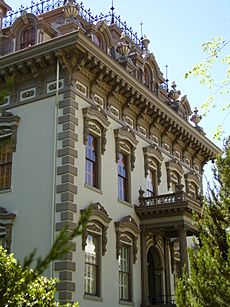Leland Stanford Mansion facts for kids
|
Leland Stanford Mansion
|
|
 |
|
| Location | 800 N St, Sacramento, California |
|---|---|
| Built | 1856 |
| Architect | Seth Babson |
| Architectural style | Second Empire |
| NRHP reference No. | 71000178 |
Quick facts for kids Significant dates |
|
| Added to NRHP | December 9, 1971 |
| Designated NHL | May 28, 1987 |
The Leland Stanford Mansion is a beautiful historic house in Sacramento, California. It's not just any old house; it's a California State Park and a very important building for the Government of California. Today, it serves as a special place where California welcomes important guests from all over the world. It's also one of the official offices for the governor of California.
This grand mansion was built way back in 1856. It used to be the home of Leland Stanford, who was the 8th governor of California. He also founded Stanford University, a famous school! Later, in 1900, the Stanford family gave the mansion to the Roman Catholic Diocese of Sacramento. For many years, it was a home for children. In 1978, the California government bought the property. They turned it into the capital's main reception center and a state park, officially called the Leland Stanford Mansion State Historic Park.
Contents
A Look at the Mansion's History
The Leland Stanford Mansion was first built by a rich merchant named Shelton C. Fogus. The original design of the house was in a style called Renaissance Revival. An architect named Seth Babson is believed to have designed it. He also designed other important buildings in Sacramento.
The Stanford Family's Home
Leland Stanford was a very successful businessman. He was the president of the Central Pacific Railroad, a huge company that built railroads. He was also becoming a big name in the Republican Party. In June 1861, he bought the house for $8,000. Soon after, he was elected as California's governor.
During his two years as governor, the Stanford Mansion was his home and his office. Other governors, like Frederick Low and Henry Huntly Haight, also used the mansion as their office after him.
Between 1871 and 1872, the Stanford family made huge changes to their home. A funny story is that Governor Stanford once had to get to his inauguration by rowboat because of floods! To stop this from happening again, the house was actually lifted twelve feet higher. This helped protect it from the Sacramento River's floods. They also added an extra floor to the bottom and the top of the mansion.
The house grew from about 4,000 square feet to a massive 19,000 square feet! Its style was changed to the popular French Second Empire look, especially with its fancy roof on the fourth floor. So, the original two-story house ended up sitting between the two new floors that were added. After Leland Stanford passed away in 1893, his wife, Jane Lathrop Stanford, continued to take care of the home.
A Home for Children
In 1900, Jane Stanford decided to give the mansion away. She donated it to the Roman Catholic Diocese of Sacramento to help children in California. The Sisters of Mercy took over and ran it as an orphanage called the Stanford and Lathrop Memorial Home for Friendless Children.
Later, in 1932, the home was given to the Sisters of Social Service. They changed it from an orphanage into a place where high school girls who needed support could live. In 1940, a fire damaged the fourth floor of the mansion.
The mansion was recognized as a special place. It became a California Historical Landmark in 1957 and a National Historic Landmark in 1987.
California's Official Reception House
In 1978, the California government bought the property to turn it into a state park. The Sisters of Social Services stayed on the grounds until 1987. Then, California State Parks officially made the mansion and its surrounding land a state historic park. The National Park Service also declared it a National Historic Landmark on May 28, 1987.
After a huge renovation that cost $22 million, the mansion finally opened for public tours in September 2005. Today, it's California's official place to welcome important leaders from all over the world.
Before the mansion reopened, California didn't have a dedicated place for official events for almost 40 years. Now, the Government of California often uses the mansion to host foreign guests. The governor also has an office there. You can take guided tours of the mansion every day, but sometimes tours might be canceled if there's an official event happening for the Governor's Office or the California State Legislature.
Bringing the Mansion Back to Life
Starting in 1991, the Stanford Mansion went through a 14-year restoration project. It cost $22 million to bring it back to its former glory. A Sacramento businessman and former Stanford University professor, Peter McCuen, helped a lot with this project.
To make sure the restoration was accurate, experts studied the house in 1986. They also used many old photographs taken in 1868 by Alfred A. Hart and in 1872 by Eadweard Muybridge. These pictures showed exactly how the rooms looked back then.
The repairs and restoration finished in 2005, and that's when the mansion opened its doors to the public. California State Parks offers guided tours where you can see the fully restored home. The rooms look just like they did in 1872! The Leland Stanford Mansion is also easy for everyone to visit, with access to the gardens, Visitor Center, restrooms, and elevators to the upper floors. There's even a special model of the Mansion in the Visitor Center that you can touch.
See also
 In Spanish: Mansión Leland Stanford para niños
In Spanish: Mansión Leland Stanford para niños









